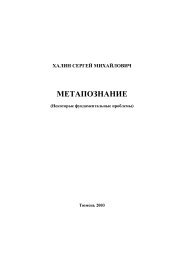The Economic History of Byzantium - Dumbarton Oaks
The Economic History of Byzantium - Dumbarton Oaks
The Economic History of Byzantium - Dumbarton Oaks
Create successful ePaper yourself
Turn your PDF publications into a flip-book with our unique Google optimized e-Paper software.
1012 NICOLAS OIKONOMIDES<br />
any significant expenses in the course <strong>of</strong> his work. Other <strong>of</strong>ficials enjoyed higher salaries;<br />
they included the hypertimos, who in1082 was entitled to 20 litrai <strong>of</strong> gold coins<br />
(though in the meantime these had lost two-thirds <strong>of</strong> their real value) and the judges<br />
<strong>of</strong> the time <strong>of</strong> Andronikos I, who collected the equivalent in silver coins <strong>of</strong> between 13<br />
and 26 litrai <strong>of</strong> gold in order that they might remain above suspicion. 102<br />
<strong>The</strong> salaries <strong>of</strong> the military and civil commanders <strong>of</strong> the provinces—the strategoi—<br />
were on a different scale and are known to us from a catalogue <strong>of</strong> the year 911/912. 103<br />
<strong>The</strong> strategoi <strong>of</strong> Asia Minor, Thrace, and Macedonia received 20–40 litrai per year,<br />
those <strong>of</strong> the maritime themes 10 litrai, and the “guardians <strong>of</strong> the passes” (the kleisourarchai),<br />
who did not hold the rank <strong>of</strong> strategos, received only 5 litrai. In the tenth century,<br />
the strategos <strong>of</strong> Taron was paid 20 litrai. 104 <strong>The</strong> strategos <strong>of</strong> Mesopotamia collected the<br />
kommerkion <strong>of</strong> his province rather than receiving a salary, while the strategos <strong>of</strong> Chaldia<br />
received half his salary and collected the other half from the kommerkion. None <strong>of</strong> the<br />
strategoi <strong>of</strong> the western provinces—from the Strymon to Italy—received a salary, but<br />
they collected synetheiai from the fortified cities in their province (see above, p. 999),<br />
amounting to sums that we can assume were commensurate with those received by<br />
their colleagues in the East, the only difference being that the money in question neither<br />
entered nor left the treasury in Constantinople, as was the case with the cash<br />
collected by the strategoi <strong>of</strong> Chaldia and Mesopotamia. Even in the public administration,<br />
which seems to have been based primarily on the roga, one can identify mechanisms<br />
for the direct collection <strong>of</strong> state revenue in the provinces and for its appropriation<br />
by civil servants asasubstitute for a salary. <strong>The</strong>se mechanisms, being more flexible,<br />
would clearly have added to the flexibility <strong>of</strong> the fiscal sector.<br />
<strong>The</strong> salaries <strong>of</strong> the strategoi may look large, but <strong>of</strong> course considerable expenditure<br />
was attached to the post. Each strategos would have to pay his bodyguard and his personal<br />
administrative staff, provide his own servants, and keep his palace in order. In<br />
other words, the roga <strong>of</strong> the strategos was in fact an annual budget in which the salary<br />
<strong>of</strong> the <strong>of</strong>ficial himself was included. To it, needless to say, we must add the various<br />
“windfalls” the strategos might manage to extract directly from the inhabitants <strong>of</strong> his<br />
theme; although such payments might amount to a considerable sum for the strategos<br />
and his staff, they appeared nowhere in the books <strong>of</strong> the <strong>of</strong>ficial state economy.<br />
<strong>The</strong> salaries the emperor paid in person to the strategoi each year totaled 26,640<br />
gold coins and accounted for a significant portion <strong>of</strong> the regular expenditure <strong>of</strong> state,<br />
given that they covered the expenses <strong>of</strong> half the provincial governors and their immediate<br />
staffs. At about this period, the Kletorologion <strong>of</strong> Philotheos, written in 899, tells us<br />
that there were a total <strong>of</strong> sixty senior state <strong>of</strong>ficials in charge <strong>of</strong> major departments, <strong>of</strong><br />
whom only twenty-five were strategoi. If we assume that the <strong>of</strong>ficials who were not strategoi,<br />
all <strong>of</strong> them based in Constantinople, were paid by roga (as seems likely), that most<br />
102 Zepos, Jus, 1:369; Nicetae Choniatae Historia, ed. J. L. van Dieten (Berlin–New York, 1975), 330<br />
(hereafter Choniates).<br />
103 De cer., 1:696–97.<br />
104 DAI, chap. 43, lines 68–69.








